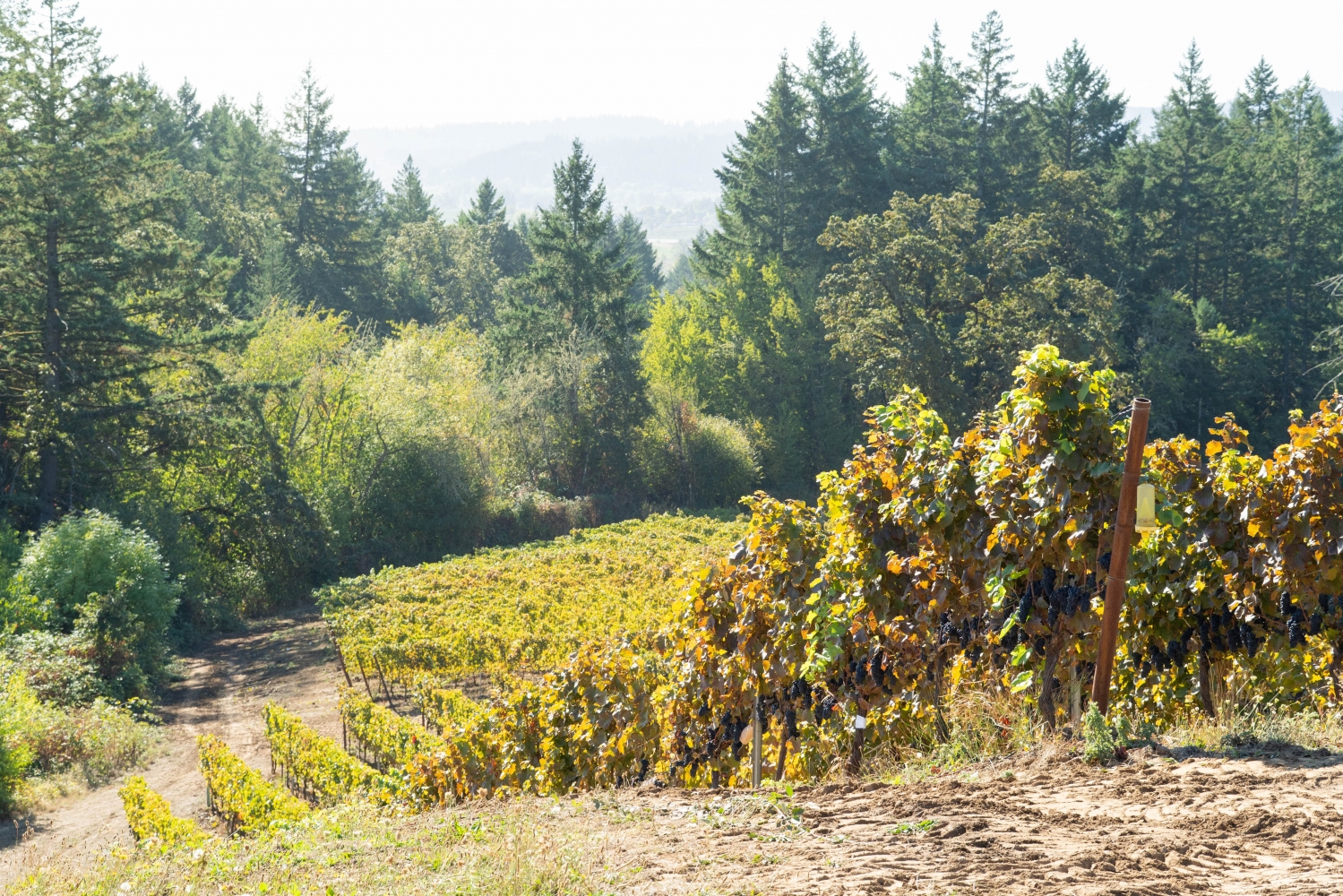

Published on: 11/18/2025
This news was posted by Oregon Today News
Description

Bree and Chad Stock stand at their winery Limited Addition in Gaston, Oregon, preparing to welcome guests to their “Come On Over October” event on Oct. 26.
Behind them, the final grapes of the season — a Willamette Valley cabernet franc — lift into the press.
“We’re usually pressing into November wrapping up closer to Thanksgiving,” Chad said, watching the last of the deep magenta grapes tumble into the stainless steel press. “With what we got this year, we’re done weeks earlier than we were before. I guess it’s part of the new normal.”
Hot, dry days across the valley pushed many vineyards to harvest earlier than ever in 2025. Sparkling wine grapes, typically picked in September, started in August. Other white and red varieties followed, struggling through triple-digit temperatures and sporadic rainfall that left many winemakers uncertain how to adapt.
While the harvest was short, most wineries reported solid yields thanks to a warm, early spring with little rain. But the pattern has vintners looking back over the past five years — and forward to what may be the new reality.
“Of the last five years, three were ‘unprecedented,’” Chad said. “At what point does it just become normal weather — and what do we understand the Willamette Valley climate to be from here on out?”

That’s part of the question explored in a study titled "Temperature-Based Climate Projections of Pinot Noir Suitability in the Willamette Valley American Viticultural Area." Co-authored by Brian Skahill and Bryan Berenguer, the study analyzed climate data and its impact on growing grapes in the valley, focusing on pinot noir.
“Excessive heat means higher sugar and less acid in the berry, which is why California pinot tastes so different from Willamette Valley pinot,” Skahill said. “But with each passing vintage, we’ve seen that late-season heat more and more — maybe our pinot is becoming the new California pinot.”
He asked the question many in the industry might not want to face: With rising temperatures, will the Willamette Valley still be ideal for pinot noir in 10 years?
Study warns of warming trends for pinot noir
“The historical data clearly shows a growing trend,” Skahill said. “It’s concerning that vineyards continue to grow and produce pinot noir here. I’d say boldly, it might be time for the Willamette Valley to stop branding itself as ‘cool climate.’ Maybe 30 years ago, sure — but now and going forward, that’s clearly not the case.”
Published in 2022, the study analyzed more than 70 years of weather data and projections to see how rising temperatures could affect local vineyards.
The findings show the average growing-season temperature in the Willamette Valley could rise by just over 3 degrees Celsius by the end of the century. Grapes could ripen about three days earlier each decade — a trend already being noticed as harvests now finish three weeks sooner than they once did.
Greg Jones, CEO of Abacela Vineyards and a vineyard climatologist, released his 2025 harvest report on his website, Climate of Wine, on Nov. 4, detailing warmer-than-average temperatures across all western growing regions. Each recorded growing degree days (GDDs) — a measure of accumulated heat — at 7% to 18% above the 1991–2020 averages.
“[The year of] 2025 will end up being one of the top one, two, or three warmest vintages on record in most of the western United States,” Jones said. “Most places are extremely close to the warmest ever.”
The Willamette Valley has long been considered near-perfect for growing pinot noir, with nearly 90% of its vineyards historically sitting in the ideal temperature range. Wines from those grapes continue to earn acclaim and awards around the world.
But the study suggests the region’s climate is shifting north. As the valley warms, the delicate, cool-climate grape that made Oregon famous may no longer thrive. Wine experts are encouraging growers to hedge their bets with warmer-climate varieties.

How pinot made Oregon famous
In the 1960s, a few wine pioneers recognized the valley’s potential. David Lett — affectionately known as “Papa Pinot” — planted the first commercial vines at Eyrie Vineyards in Dundee in 1965.
Fourteen years later, Eyrie’s 1975 South Block Reserve placed alongside top wines in the prestigious Paris tasting, putting Oregon on the international wine map.
Through the 1970s and ’80s, wineries rushed to claim land in the valley’s rolling hills, once filled mostly with oak, fruit and nut trees. Burgundy’s famed Domaine Drouhin cemented the region’s reputation when it purchased a 235-acre estate in the Dundee Hills.
All for largely one grape: pinot noir.
Today, the Willamette Valley Wineries Association reports 21,334 acres of pinot noir planted — 68% of all vineyard acreage between the Coast Range and the Cascades, stretching 150 miles from Portland to just south of Eugene. The valley produces about 70% of Oregon’s pinot noir.
According to the Wine & Spirit Education Trust, vines can remain productive for 50 years, though quality typically declines after 30. Many of the valley’s pinot vines, planted between the 1970s and 1990s, are nearing the end of their prime — which could come sooner if affected by red blotch disease, present around Oregon’s vines and in parts of the Dundee Hills.
Skahill said vineyard owners should begin thinking creatively to build resilience in an industry facing both climate and market pressures.
“The solutions we presented focus on mitigating risks,” he said. “Those willing to accept and act on this data — to plan and replant — could be the next generation of winners, just like the pioneers of the ’80s and ’90s.”
Jones echoed the sentiment and is urging winery owners to see this as an opportunity to provide more control and consistency in an industry that has been rocked by everything from climate to government to changing preferences.
“Planting pinot noir used to be the risky move — now it’s the safe move,” he said. “What makes people in the wine industry successful is hedging their bets. Bordeaux grows five or six red grapes so one can succeed when another struggles. If all you grow is pinot noir, you’re beholden to it when it’s a bad year — and those are becoming more frequent.”
New grapes, new opportunities

Study co-author Berenguer — a viticulturist and oenologist at McMinnville’s Chemeketa Community College Yamhill Campus and co-owner of Human Cellars in Dundee — said the report influenced his decision to grow no pinot noir at all.
Instead, he planted gamay, grüner veltliner, chenin blanc, and lagrein — all warmer-climate varieties that have performed well.
“My neighbors told me I was crazy,” he said. “They said, ‘You don’t have any pinot noir? That’s pretty stupid.’ But now, each harvest of those grapes is getting stronger, while pinot is harvested earlier.”
The Stocks’ Limited Addition Wines is also focused on alternative grapes. Bree Stock, the Pacific Northwest’s first and only female Master of Wine, said she’s experimenting with several varieties, but cabernet franc has her attention.
She called cabernet franc an “unsung hero” in the Willamette Valley. Traditionally a warm-weather grape, it develops its signature green pepper and mint character in drier regions such as Yakima, Walla Walla and the Columbia Valley.
In the Willamette Valley, however, the grape ripens later and slower, allowing for balanced sugar and acid development — and more complex wines.
Later ripening also means lower sugar levels during peak fire season, reducing the risk of smoke taint if wildfires return, as they did in 2020. Cabernet franc’s looser clusters also improve airflow, limiting damage from smoke or mold.
Because the region is still cooler than eastern Oregon, Bree said the grape benefits from more sunlight exposure, which helps reduce vegetal flavors and produces a smoother, more marketable wine.
“I just think cabernet franc is more of a viable premium wine that will hold its price point like pinot noir,” she said. “It’s got the quality, the age-worthiness, and the complexity to appeal to both seasoned and younger consumers.”

Breaking the pinot mold
For the Stocks and other winemakers, it’s not about replacing pinot noir altogether — it’s about diversity in a monoculture.
The Willamette Valley’s heavy reliance on marketing and selling a single grape has created this monoculture. When the weather is ideal, high-quality pinot floods the market and drives down prices. When it’s not, the entire region struggles to sell lower-quality wines at the same high prices.
“It’s an outdated model,” Chad Stock said. “Maybe when the Willamette Valley was the new wine region, wine sold easily at higher prices. But now, there are signs it’s time to change — or we could be stuck.”
Skahill, Berenguer, the Stocks and Jones all agree: Change doesn’t have to be frightening.
“Pinot noir is still a marquee variety for the state and will be for years to come,” Jones said. “But I like to highlight what others are doing — experimenting around the edges, finding grapes that do well in their environments, that make us unique.”
Berenguer added that promoting alternative grape varieties could breathe new life into a region that’s been known for selling the same product since the ’70s.
“People are kind of pinot noir-ed out,” Berenguer said. “If you try to sell an Oregon wine in Texas, nobody knows what it is if it’s not pinot. Nobody thinks gamay when they think Oregon wine. It’s something we as an industry need to work on together.”
Jones, who serves as the board chair of the Oregon Wine Board, said another challenge will be marketing. The state’s tourism and wine associations continue to promote the Willamette Valley as a “Pinot Paradise,” but shifting that narrative could help draw new audiences.
“I’m all for anybody doing anything, as long as they’re good grape growers and make good wine that allows Oregon wine to shine,” Jones said. “There really is a market for pinot noir, and there is no reason to push away from that wholeheartedly. I think we should shift into different projects and focus on the excitement of that. Oregon wine’s pioneer spirit is back.”
And, just like the pioneers of the 1960s, Jones said, progress depends on risk-takers willing to plant, test, and share their results.
“When you grow a diversity of varieties, you learn what works best and what makes you more adaptable,” he said. “This is a chance for growers to think differently — and maybe plant the next grape that defines the valley’s future.”
Branden Andersen is the founding editor of Newsberg. This republished story is part of OPB’s broader effort to ensure that everyone in our region has access to quality journalism that informs, entertains and enriches their lives. To learn more, visit opb.org/partnerships.
News Source : https://www.opb.org/article/2025/11/18/oregon-pinot-noir-climate-change/
Other Related News
11/18/2025
Oregon Democrats have agreed to backfill 75 million in lost Planned Parenthood dollars mon...
11/18/2025
The advisory was for Oregon Lower Treasure ValleyVisibility is improving across much of th...
11/18/2025
Zach surprised Isabelle with a ring at Regions Hospital where both arrived by ambulance in...
11/18/2025
Need a last-minute ingredient for your feast Heres what stores will keep their doors open ...
11/18/2025











